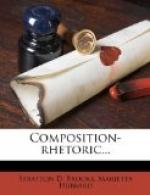+168. Exposition by Giving Particulars or Details.+—One of the most natural methods of explaining is to give particulars or details. After a general statement has been made, our minds naturally look for details to make the meaning of that statement clearer. (See Sections 45-47.) This method is used very largely in generalized descriptions and narrations.
Notice the use of particulars or details in the following examples:—
Happy the boy who knows the secret of making a willow whistle! He must know the best kind of willow for the purpose, and the exact time of year when the bark will slip. The country boy seems to know these things by instinct. When the day for whistles arrives he puts away marbles and hunts the whetstone. His jackknife must be in good shape, for the making of a whistle is a delicate piece of handicraft. The knife has seen service in mumblepeg and as nut pick since whistle-making time last year. Surrounded by a crowd of spectators, some admiring, some skeptical, the boy selects his branch. There is an air of mystery about the proceeding. With a patient indulgent smile he rejects all offers of assistance. He does not attempt to explain why this or that branch will not do. When finally he raises his shining knife and cuts the branch on which his choice has fallen, all crowd round and watch. From the large end between two twigs he takes a section about six inches long. Its bark is light green and smooth. He trims one end neatly and passes his thumb thoughtfully over it to be sure it is finished to his taste. He then cuts the other end of the stick at an angle of about 45 deg., making a clean single cut. The sharp edge of this is now cut off to make a mouthpiece. This is a delicate operation, for the bark is apt to crush or split if the knife is dull, or the hand is unskillful. The boy holds it up, inspecting his own work critically. Sometimes he is dissatisfied and cuts again. If he makes a third cut and is still unsuccessful he tosses the spoiled piece away. It is too short now. A half dozen eager hands reach for the discarded stick, and the one who gets it fondles it lovingly. I once had such a treasure and cherished it until I learned the secret of the whistle-maker’s art. He next places the knife edge about half an inch back from the end of the mouthpiece and cuts straight towards the center of the branch about one-fourth the way through. A three-cornered piece is now cut out, and the chip falls to the ground unheeded.
When this is finished the boy’s eye runs along the stick with a calculating squint. The knife edge is placed at the middle, then moved a short distance towards the mouthpiece. With skillful hand he cuts through the bark in a perfect circle round the stick. While we watch in fascinated silence, he takes the knife by the blade and resting the unfinished whistle on his knees he strikes firmly but gently the part of the stick between the ring and the mouthpiece.




